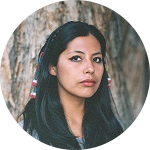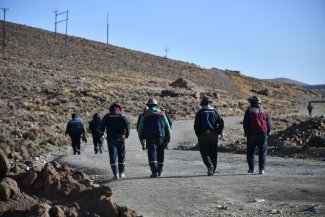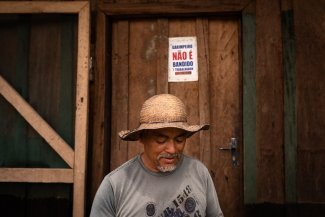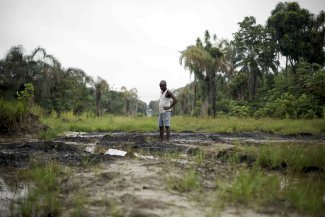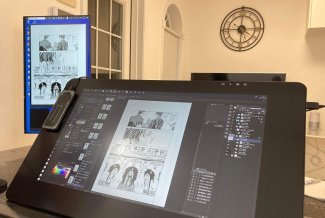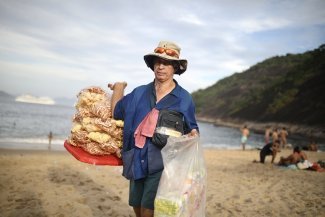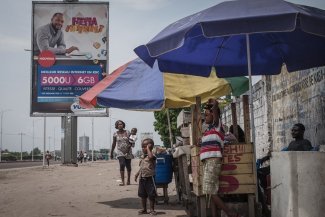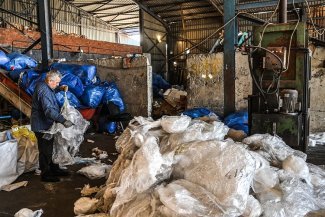Located in the Bolivian Altiplano at an altitude of more than 4,000 metres, the community of Puñaca Tinta María is fighting for its survival. The Uru Murato people, known as the “people of the water”, have lived on the islands of Lake Poopó for centuries. But as the lake began to disappear, their way of life was radically altered.
By 2015, Lake Poopó had dried up completely. Its disappearance is due to several factors, including water-intensive zinc and tin mining operations, quinoa cultivation and global warming, which is reducing rainfall and intensifying evaporation in the Altiplano. In addition, the community is currently facing a severe drought and only has one well left for all of its inhabitants.
The photos in this report are part of a photographic exhibition by artist and journalist Sara Aliaga Ticona, produced in collaboration with the community of Puñaca Tinta María. Ticona also made a short documentary entitled Urus, del agua vengo (Urus, From the Water I Come) which depicts the worldview, struggle and resilience of the Uru Murato people, whose way of life is under greater threat than ever. The disappearance of their culture would mean an irreparable loss for Bolivia.

The cosmovision of the Uru Murato nation is based on its relationship with water, a link so deep that they are known as the “people of the water”. 15 June 2023, Oruro.
“We don’t have water, we can’t plant or grow crops because we don’t have the land for it,” laments community leader Erasmo Zuna, 33. The ten families still living in Puñaca Tinta María face a twofold challenge: developing economic activities that allow them to continue living in their ancestral homeland while at the same time preserving their history and collective memory to save the Uru Murato cosmovision from disappearing altogether.

Portrait of Uru Murato artisan María Choque, in the community of Puñaca Tinta María, Poopó Municipality. 15 June 2023.
“We used to live off the lake and its fish, and we hunted the birds that lived on the Poopó. We lived on islands and rarely went on the land,” says Maria Choque, an artist from the community. Her embroidered canvases recount the life that her people have lived on the lake since ancient times.
Nestled amongst the reeds, their way of life was made possible by the lake’s abundance. “We have been abandoned. Nobody remembers us, there is no water or land to cultivate, no authority to help us”. Many of the inhabitants have left for other parts of Bolivia or abroad, unable to imagine a future for themselves in Puñaca Tinta María.

Aerial view of the town of Poopó, contaminated by intense mining activity. 13 June 2023.
The mining industry poses another threat to the Uru Murato’s way of life. Mining companies, which have a major presence in the zinc and tin-rich area, have both contributed to the drying up of Lake Poopó and contaminated the community’s land, and significantly its only well. “Look at the well, would you drink water from it?” asks Zuna, as he gives us a tour of the community. The water that is visible between two planks of wood has an oily sheen. Tests carried out a few weeks ago revealed the presence of heavy metals such as lead and mercury. “With no outside help to buy water, we have no choice but to drink the water from this well,” continues Zuna with an air of resignation. Other nearby communities have faced similar problems.

Erasmo Zuna, chief of the Uru Murato community in Puñaca Tinta María, hunts a bird called Pariguana using an ancestral instrument of his people called ‘Liwi’, 15 June 2023, Oruro, Bolivia.
But not everyone has given up hope. Members of the community are currently developing several economic activities with a focus on local and cultural tourism meant to introduce people to the Uru Murato’s way of life and cosmovision.
Abdón Choque, a young man from Puñaca Tinta María, has trained in community tourism. He came up with the idea of opening a small museum in the town dedicated to the 38 species of birds that once lived on Lake Poopó. “Each species had a different use,” he explains. “Some were used for their meat, others for their eggs. Some guided us to areas of the Poopó rich in fish”. He plans to eventually compile a list of the different plants traditionally used by the Uru Murato and open a small tourist accommodation.
Two other activities are also being developed: the production and sale of salt – encouraged by the increasing salinisation of the area around the former lake – and the sale of handicrafts, both in Puñaca Tinta María and soon in Oruro, the department’s largest city.

The leaders of the Uru Murato people of Puñaca Tinta María, Poopó Municipality, perform a ritual asking for water on the former site of Lake Poopó. This ritual is only performed by the leaders of the community. 14 June 2023, Oruro.
Many in the community still hold onto the hope that Lake Poopó will one day return. This is not the first time the lake has disappeared. Between 1939 and 1944, it dried up completely. At other times during the 20th century, its level dropped drastically, such as in 1969 and 1973.

Portrait of spiritual leader Felix Mauricio Zuna performing a ritual asking for water at the former site of Lake Poopó. The ritual is only performed by the leaders of the community. 14 June 2023.
The Uru Murato chiefs regularly perform a sacred ritual to invoke rainfall and bring water back to the lake. Erasmo Zuna, community elder Felix Mauricio Zuna and Pablo Flores visit Cerro Jututilla, an important spiritual site for their people. “This hill is like a god for us,” says Zuna. “We ask it to bring back the lake. In their day, my grandparents used to say, ‘in ten years’ time, the lake will come back,’ and it worked. That’s why we follow these customs and traditions”.



